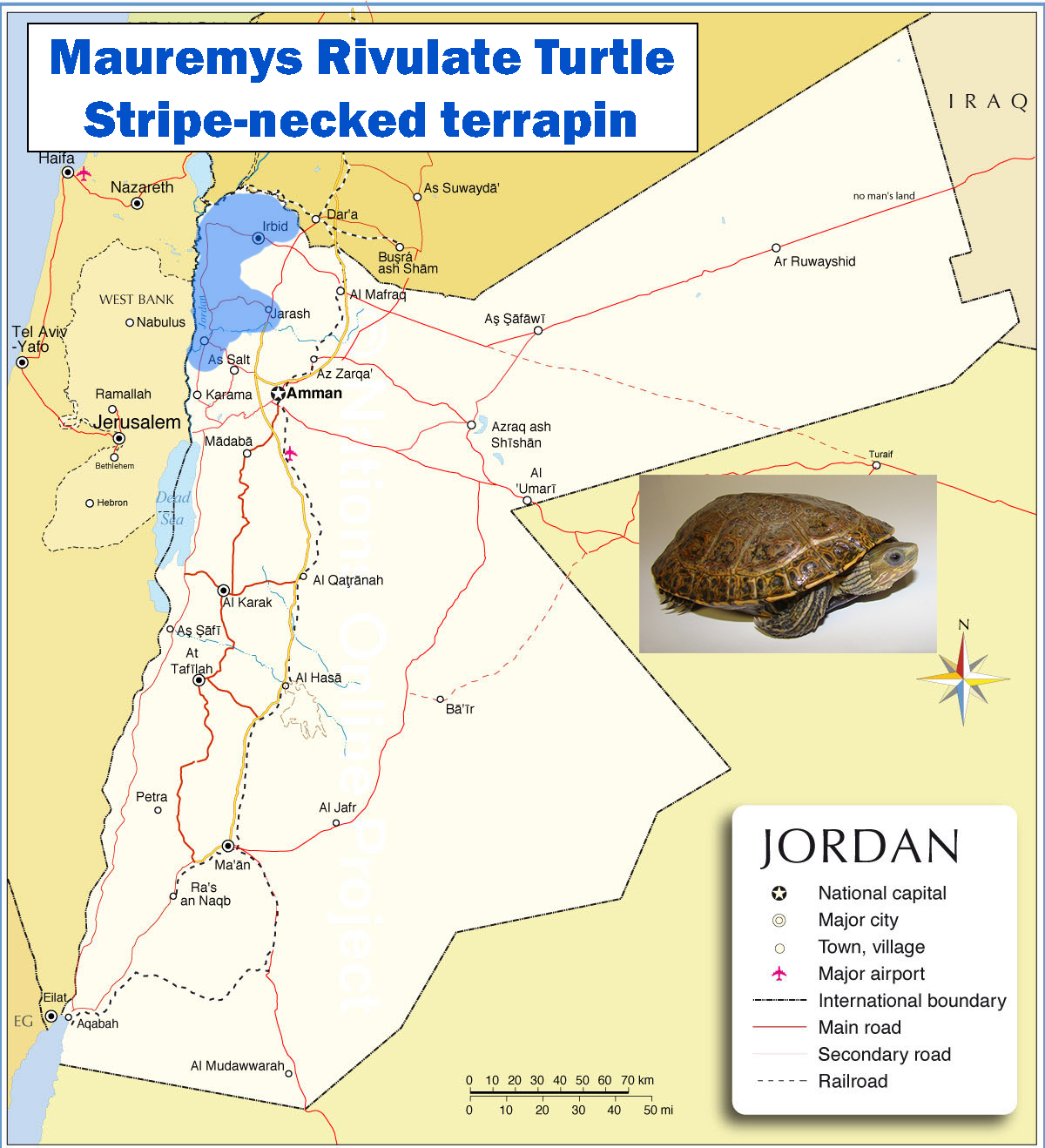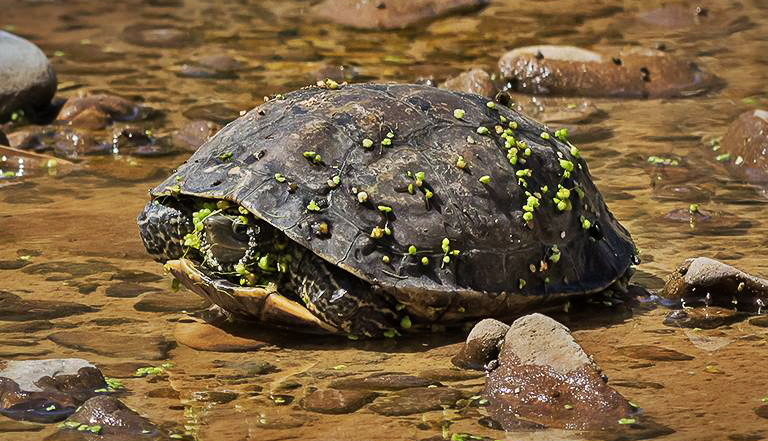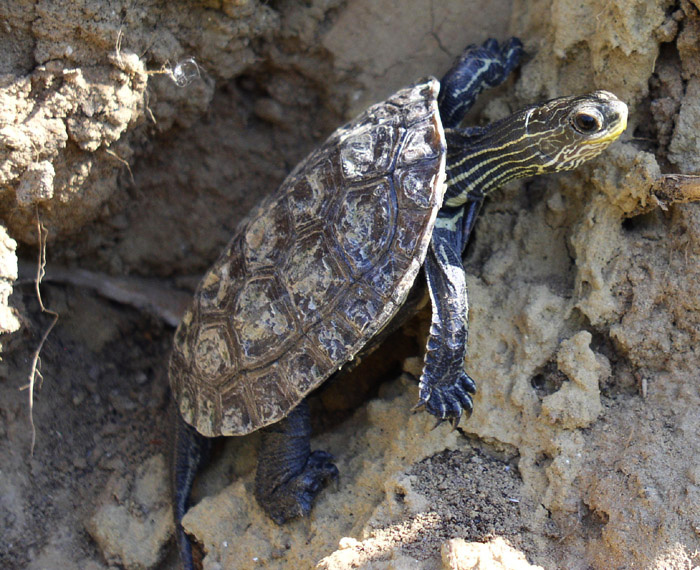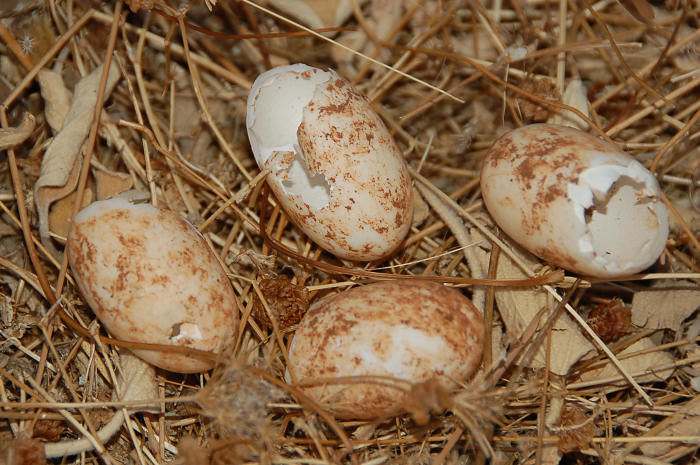 Species-in-Jordan
Species-in-Jordan
CHELONIANS IN JORDAN
Mauremys Rivulata
Common Name:
Stripe-necked Terrapin
Description:
The carapace is dorso-ventrally flattened with a much wider posterior end. The number of marginal is 22, the nuchal is smaller than any marginal and much wider posteriorly. The centrals are wider than long. Males have a slightly concave plastron, the hind lobe of the plastron is deeply notched posteriorly. Also, the vent is located more distally beyond the marginal of the carapace, and the tail is longer than in females. All toes are joined by thick webbing, as far as the claws, which ends in irregularly serrated edges. The forelimbs have five clawed toes but the hindlimbs four.
Colour:
In adults the carapace is olive-green to brown with yellowish-gray irregular lines with dark edges which gradually disappear with age. The plastron is predominantly black or dark brown, the bridge is always dark with at most some small yellow spots or marks. The neck bears numerous yellow lines with dark edges.
Habitat:
The stripe-necked terrapin was collected in Jordan from natural and man-made ponds, slow streams and irrigation canals, whether clear fresh water or brackish, but not from fast running streams. All stripe-necked turtles collected or observed were quite capable of swimming, as well as of quite fast moving on land, but they did not go far from the water bodies. They spend the winter buried in the mud at the bottom of the water body.
Feeding:
On several occasions M. rivulata was seen feeding on algae, detritus, fish, tadpoles, aquatic insects, and frogs. In two cases the strip-necked terrapin was seen feeding on hunted birds fallen into the pool of Brides Pond.
Feeding activity is more intense in hot season than in colder ones, stripe-necked terrapins older than one year are opportunistic omnivores feeding on a wide range of detritus, animal and plant sources, readily available in their surroundings. Young stripe-necked turtles are inclined to be more carnivorous and begin to consume plant material as they grow older. However, the food varies with the habitat type, saprobiontic material in organic (Sewage) contaminated habitats replace filamentous algae and plant sources in unpolluted habitats. Also, detritus increases in the diet of M. rivulata inhabiting organic polluted habitats.
The ecological flexibility of M. rivulata results from three factors are responsible for a range extension within the last years in Jordan:
1- Its capability to survive in most types of water of different quality Or transparency, to highly polluted water bodies.
2- It can survive in both natural and man-made shallow habitats with soft bottoms, even on farms along the upper Jordan Valley.
3- It is an opportunistic omnivore feeding on a wide range of food resources.
Activity:
M. rivulata is active most of the year except in very cold winters, none were seen hibernating. In spring and late fall they start their activity after sunrise, in summer when the ambient temperature exceeds 30ْ C, they are active after sunrise and late in afternoon. At noon, they hide in water underneath the algae and water weeds or in the mud.
Reproduction:
M. rivulata lays between 4–5 and 12 eggs per one Clutch, in Jordan mating was witnessed several times during November – March. Many studies reported activities of mating occurs in April during spring season and also occasionally in fall with a peak at midwinter & activity of egg laying during June, mid of July to the beginning of August, that means these activities take place during the period of maximum rainfall, lowest ambient temperature and shortest day length.
Morphometric Studies:
In the Jordanian M. rivulata specimens, three measurements are significantly higher in females than in males: head width, length and postcloacal tail length, while the precloacal tail length was higher in males than in females. This agrees with the findings reported by researchers in (1980) who indicated that the sexual dimorphism is present among the stripe-necked terrapin.


